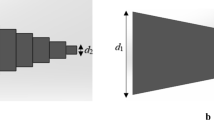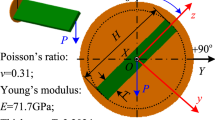Abstract
We present a novel consistent singularity-free strain-based finite element formulation for the analysis of three-dimensional frame-like structures. Our model is based on a geometrically exact finite-strain beam theory, quaternion parametrization of spatial rotations, assumption that the strain measures are constant along the length of the element and a proper choice of basis for the translational strain vector representation. As it is common for strain-based elements, the present formulation does not suffer from shear locking. A comparison of our results with the results from the literature and a commercial finite element analysis software demonstrates the advantages of the proposed formulation, especially when the structure is subjected to larger shear deformations. This stems from the fact that our model ensures a mathematically consistent updating procedure for all the quantities describing the beam. This aspect is often overlooked, since most of the numerical cases from other studies on this topic engage rather small-shear strains for which the consistent update is not crucial as the number of elements is increased.













Similar content being viewed by others
References
Hover FS (1997) Simulation of stiff massless tethers. Ocean Eng 24(8):765–783
Nazmy AS, Abdel-Ghaffar AM (1990) Three-dimensional nonlinear static analysis of cable-stayed bridges. Comput Struct 34(2):257–271
Coleman BD, Swigon D (2000) Theory of supercoiled elastic rings with self-contact and its application to DNA plasmids. J Elast 60(3):173–221
Nakano A (1999) A rigid-body-based multiple time scale molecular dynamics simulation of nanophase materials. Int J High Perform Comput 13(2):154–162
Spillman J, Teschner M (2008) Cosserat nets. IEEE Trans Vis Comput Graph 15(2):325–338
Gilles B, Bousquet G, Faure F, Pai DK (2011) Frame-based elastic models. ACM Trans Graph 30(2):15:1–15:12
Horn BKP (1987) Closed-form solution of absolute orientation using unit quaternions. J Opt Soc Am A 4(4):629–642
Trivedi D, Lotfi A, Rahn CD (2008) Geometrically exact models for soft robotic manipulators. IEEE Trans Robot 24(4):773–780
Reissner E (1972) On one-dimensional finite-strain beam theory: the plane problem. Z Angew Math Phys 23(5):795–804
Antman SS (2005) Nonlinear problems of elasticity. Springer, New York
Reissner E (1981) On finite deformations of space-curved beams. Z Angew Math Phys 32(6):734–744
Simo JC (1985) A finite strain beam formulation. The three-dimensional dynamic problem. Part I. Comput Method Appl Mech 49(1):55–70
Simo JC, Vu-Quoc L (1986) A three-dimensional finite-strain rod model. Part II: computational aspects. Comput Method Appl Mech 58(1):79–116
Cardona A, Géradin M (1988) A beam finite element non-linear theory with finite rotations. Int J Numer Methods Eng 26(11):2403–2438
Ibrahimbegović A (1995) On finite element implementation of geometrically nonlinear Reissner’s beam theory: three-dimensional curved beam elements. Comput Methods Appl Mech 22(1–2):11–26
Jelenić G, Saje M (1995) A kinematically exact space finite strain beam model—finite element formulation by generalized virtual work principle. Comput Methods Appl Mech 120(1–2):131–161
Smoleński WM (1999) Statically and kinematically exact nonlinear theory of rods and its numerical verification. Comput Methods Appl Mech 178(1–2):89–113
Argyris J (1982) An excursion into large rotations. Comput Methods Appl Mech 32(1–3):85–155
Argyris J, Poterasu VF (1993) Large rotations revisited application of Lie algebra. Comput Methods Appl Mech 103(1–2):11–42
Géradin M, Rixen D (1995) Parametrization of finite rotations in computational dynamics: a review. Revue Européenne des Eléments Finis 4(5–6):497–553
Spring KW (1986) Euler parameters and the use of quaternion algebra in the manipulation of finite rotations: a review. Mech Mach Theory 21(5):365–373
Atluri SN, Cazzani A (1995) Rotations in computational solid mechanics. Arch Comput Methods Eng 2(1):49–138
Zupan E, Saje M, Zupan D (2009) The quaternion-based three-dimensional beam theory. Comput Methods Appl Mech 198(49–52):3944–3956
Češarek P, Saje M, Zupan D (2012) Kinematically exact curved and twisted strain-based beam. Int J Solids Struct 49(13):1802–1817
Zupan D, Saje M (2003) Finite-element formulation of geometrically exact three-dimensional beam theories based on interpolation of strain measures. Int J Solids Struct 192(49–50):5209–5248
Stuelpnagel J (1964) On the parametrization of the three-dimensional rotation group. SIAM Rev 6(4):422–430
Pimenta PM, Campello EMB, Wriggers P (2008) An exact conserving algorithm for nonlinear dynamics with rotational DOFs and general hyperelasticity. Part 1: rods. Comput Mech 42(5):715–732
Neto AG, Martins CA, Pimenta PM (2014) Static analysis of offshore risers with a geometrically-exact 3D beam model subjected to unilateral contact. Comput Mech 53(1):125–145
Ibrahimbegović A (1997) On the choice of finite rotation parameters. Comput Methods Appl Mech 149(1–4):49–71
Crisfield MA, Jelenić G (1999) Objectivity of strain measures in the geometrically exact three-dimensional beam theory and its finite-element implementation. Proc Roy Soc Lond A Math 455(1–4):1125–1147
Battini JM, Pacoste C (2002) Co-rotational beam elements with warping effects in instability problems. Comput Methods Appl Mech 191(17–18):1755–1789
McRobie FA, Lasenby J (1999) Simo–Vu Quoc rods using Clifford algebra. Int J Numer Methods Eng 45(4):377–398
Zupan E, Saje M, Zupan D (2013) Dynamics of spatial beams in quaternion description based on the Newmark integration scheme. Comput Mech 51(1):47–64
Zupan E, Zupan D (2016) Velocity-based approach in non-linear dynamics of three-dimensional beams with enforced kinematic compatibility. Comput Methods Appl Mech 310:406–428
Zupan E, Zupan D (2019) On conservation of energy and kinematic compatibility in dynamics of nonlinear velocity-based three-dimensional beams. Nonlinear Dyn 95(2):1379–1394
Tabarrok B, Farshad M, Yi H (1988) Finite element formulation of spatially curved and twisted rods. Comput Methods Appl Mech 70(3):275–299
Zupan D, Saje M (2006) The linearized three-dimensional beam theory of naturally curved and twisted beams: the strain vectors formulation. Comput Methods Appl Mech 195(33–36):4557–4578
Ward JP (2012) Quaternions and Cayley numbers: algebra and applications. Springer, Berlin
Zupan E, Zupan D (2014) On higher order integration of angular velocities using quaternions. Mech Res Commun 55:77–85
Zupan E, Saje M, Zupan D (2013) On a virtual work consistent three-dimensional Reissner–Simo beam formulation using the quaternion algebra. Acta Mech 224(8):1709–1729
Room TG (1952) The composition of rotations in Euclidean three-space. Am Math Mon 59(10):688–692
The Mathworks, Inc (2019) MATLAB version 9.6.0.1150989 (R2019a). Natick, Massachusetts
ANSYS, Inc. (2019) Academic research mechanical, release R2 2019. Help system, element reference
Dassault Systèmes Simulia Corp. (2019) ABAQUS documentation 6.13, Providence, RI, USA
Ibrahimbegović A, Taylor RL (2002) On the role of frame-invariance in structural mechanics models at finite rotations. Comput Methods Appl Mech 191(45):5159–5176
Acknowledgements
This work was supported by the Slovenian Research Agency through Grants P2-0263 and J2-8170. The support is gratefully acknowledged.
Author information
Authors and Affiliations
Corresponding author
Additional information
Publisher's Note
Springer Nature remains neutral with regard to jurisdictional claims in published maps and institutional affiliations.
Rights and permissions
About this article
Cite this article
Lolić, D., Zupan, D. & Brojan, M. A consistent strain-based beam element with quaternion representation of rotations. Comput Mech 65, 1397–1412 (2020). https://doi.org/10.1007/s00466-020-01826-0
Received:
Accepted:
Published:
Issue Date:
DOI: https://doi.org/10.1007/s00466-020-01826-0




